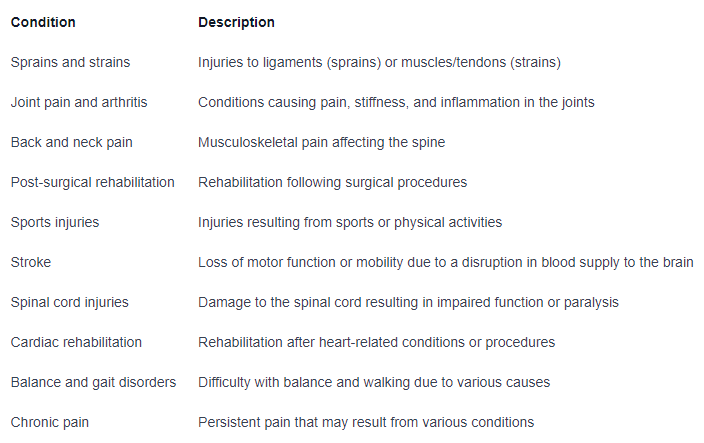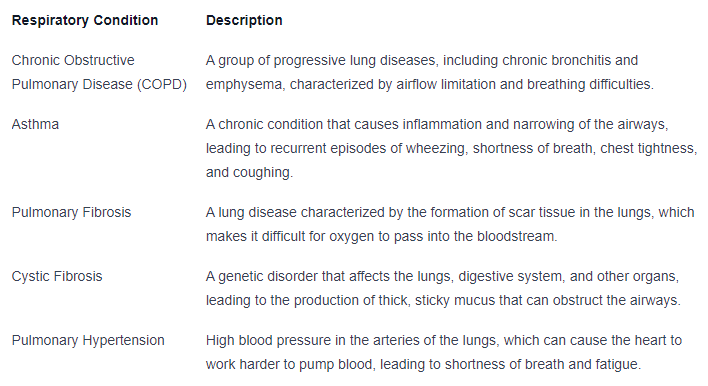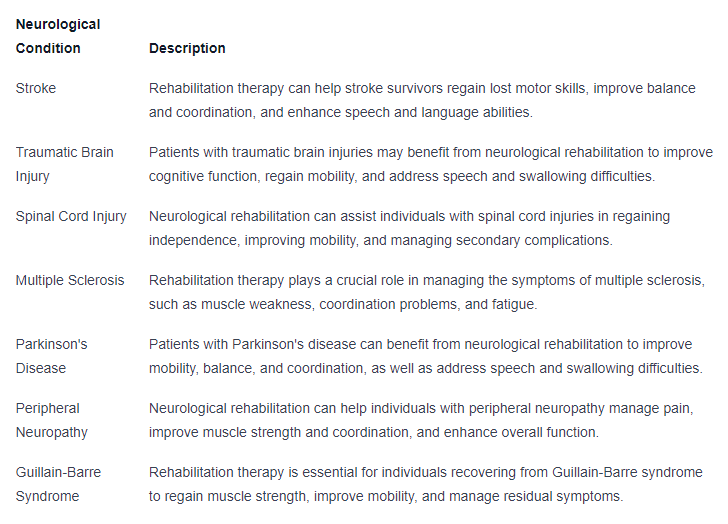7 Types of Rehabilitation Therapy

Understanding Rehabilitation Therapy
Rehabilitation therapy plays a crucial role in helping individuals regain function, independence, and quality of life following an injury, illness, or surgery. It encompasses a range of specialized therapies designed to address different aspects of physical, cognitive, and emotional recovery. In this section, we will explore what rehabilitation therapy is and the importance it holds in the healthcare field.
What is Rehabilitation Therapy?
Rehabilitation therapy, also known as rehab therapy, is a multidisciplinary approach to healthcare that aims to restore and enhance the functional abilities of individuals affected by various conditions. It involves the use of therapeutic interventions, exercises, and techniques to improve mobility, strength, coordination, communication, and overall well-being.
Rehabilitation therapy is typically provided by a team of healthcare professionals, including physical therapists, occupational therapists, speech therapists, and other specialized therapists. These professionals work together to develop personalized treatment plans tailored to the specific needs and goals of each individual. Through a combination of exercises, activities, and interventions, rehabilitation therapy aims to optimize physical, cognitive, and emotional functioning, enabling individuals to regain independence and improve their quality of life.
Importance of Rehabilitation Therapy
Rehabilitation therapy plays a vital role in the recovery process for individuals with a wide range of conditions, injuries, or disabilities. It helps to minimize the impact of these conditions on daily life, promotes healing, and maximizes functional potential. Here are a few key reasons why rehabilitation therapy is important:
- Restoring Function: Rehabilitation therapy focuses on improving physical, cognitive, and emotional function, enabling individuals to regain independence and perform daily activities with greater ease.
- Pain Management: Many rehabilitation therapies incorporate techniques to manage pain, helping individuals cope with discomfort and reduce reliance on medication.
- Preventing Complications: Rehabilitation therapy aims to prevent secondary complications that may arise from immobility or functional limitations, such as muscle atrophy, contractures, or pressure ulcers.
- Enhancing Quality of Life: By addressing physical, cognitive, and emotional challenges, rehabilitation therapy helps individuals improve their overall well-being and quality of life.
- Promoting Independence: Rehabilitation therapy focuses on developing skills and strategies that allow individuals to regain independence, whether it's through improving mobility, enhancing communication, or adapting daily routines.
- Supporting Long-Term Health: Rehabilitation therapy provides individuals with the tools and knowledge needed to manage their condition effectively, promoting long-term health and preventing future complications.
By understanding the importance of rehabilitation therapy, individuals can make informed decisions about their healthcare and seek the appropriate therapies to support their recovery and well-being. The following sections will provide an overview of the seven types of rehabilitation therapy, each with its own focus and specific conditions that it addresses.
Physical Therapy
Physical therapy is a type of rehabilitation therapy that focuses on improving and restoring physical function through targeted exercises, manual therapy, and other interventions. It aims to reduce pain, improve mobility, and enhance overall physical performance. Physical therapy is typically provided by trained professionals, such as physical therapists or physiotherapists.
Overview of Physical Therapy
Physical therapy encompasses a wide range of techniques and modalities tailored to meet the specific needs of each individual. It begins with a comprehensive assessment to identify the areas of concern and develop a personalized treatment plan. The treatment plan may include various interventions, such as:
- Therapeutic exercises: These exercises aim to strengthen muscles, improve flexibility, and enhance balance and coordination. They may include stretching, resistance training, and functional movements.
- Manual therapy: This involves hands-on techniques performed by the physical therapist to mobilize joints, manipulate soft tissues, and alleviate pain. Manual therapy can help improve joint mobility and reduce muscle tension.
- Electrical stimulation: Electrical stimulation techniques, such as transcutaneous electrical nerve stimulation (TENS) or electrical muscle stimulation (EMS), may be used to relieve pain, reduce muscle spasms, and promote muscle re-education.
- Heat or cold therapy: The application of heat or cold can help alleviate pain, reduce inflammation, and promote healing. Heat therapy may involve the use of warm towels or heating pads, while cold therapy may include ice packs or cold compresses.
- Assistive devices: Physical therapists may recommend the use of assistive devices, such as crutches, canes, or splints, to support mobility and enhance independence during the rehabilitation process.
Common Conditions Treated with Physical Therapy
Physical therapy can address a wide range of conditions and injuries affecting the musculoskeletal, neurological, and cardiovascular systems. Some common conditions treated with physical therapy include:

Physical therapy has proven to be effective in managing and improving outcomes for individuals with these conditions. By addressing the underlying impairments and promoting functional recovery, physical therapy plays a crucial role in restoring physical function and enhancing quality of life.
Occupational Therapy
Occupational therapy is a vital form of rehabilitation therapy that focuses on helping individuals regain independence and improve their ability to perform daily activities. Through a combination of therapeutic interventions and techniques, occupational therapists assist patients in developing the skills needed to engage in meaningful occupations.
Overview of Occupational Therapy
Occupational therapy aims to enhance the physical, cognitive, and emotional well-being of individuals by addressing the barriers that may hinder their participation in everyday activities. Occupational therapists work closely with patients to assess their functional abilities, set goals, and design personalized treatment plans.
During occupational therapy sessions, various techniques and interventions are employed to promote independence and improve quality of life. These may include:
- Activities of Daily Living (ADL) training: Assisting patients in developing or relearning skills necessary for self-care tasks, such as bathing, dressing, and feeding.
- Adaptive equipment and assistive technology: Recommending and providing devices or tools that aid in overcoming physical limitations and facilitate independent functioning.
- Environmental modifications: Identifying and implementing changes in the physical environment to promote safety and accessibility.
- Cognitive rehabilitation: Utilizing strategies to improve memory, attention, problem-solving, and other cognitive abilities affected by injury or illness.
- Sensory integration: Addressing sensory processing issues and helping patients develop sensory-motor skills for improved coordination and sensory regulation.
Occupational therapy can benefit individuals of all ages, from children to older adults. It is often utilized in various settings, including hospitals, rehabilitation centers, schools, and community-based clinics.
Common Conditions Treated with Occupational Therapy
Occupational therapy is a versatile discipline that can address a wide range of conditions and challenges. Some common conditions treated with occupational therapy include:

Occupational therapy is a valuable form of rehabilitation therapy that aims to enhance individuals' overall well-being and independence in daily life. By addressing the unique challenges faced by each individual, occupational therapists empower their patients to lead fulfilling and meaningful lives.
Speech Therapy
Speech therapy is a specialized form of rehabilitation therapy that focuses on improving communication skills and addressing speech and language disorders. It is designed to help individuals overcome difficulties in speech, language, swallowing, and other related areas. Let's take a closer look at the overview of speech therapy and the common conditions treated through this therapy.
Overview of Speech Therapy
Speech therapy involves the assessment, diagnosis, and treatment of various speech and language disorders. It is provided by speech-language pathologists (SLPs) who are trained professionals specializing in communication disorders. SLPs work with individuals of all ages, from infants to adults.
The goal of speech therapy is to enhance communication abilities, promote functional speech and language skills, and improve overall quality of life. The therapy sessions are tailored to the specific needs of each individual, taking into account their age, condition, and communication goals.
Speech therapy may involve a combination of techniques and exercises that target different aspects of communication, such as articulation, fluency, voice, comprehension, and social interaction. The therapy sessions may include activities to improve speech clarity, language comprehension and expression, swallowing abilities, and cognitive-communication skills.
Common Conditions Treated with Speech Therapy
Speech therapy can address a wide range of conditions and disorders related to speech, language, and swallowing. Some common conditions treated through speech therapy include:

These are just a few examples of the conditions that speech therapy can address. Speech therapy programs are personalized based on individual needs and goals, and the duration and frequency of therapy sessions may vary depending on the severity of the condition and the progress made.
Speech therapy plays a vital role in helping individuals improve their communication skills, overcome challenges, and achieve greater independence. Through targeted interventions and a holistic approach, speech therapy empowers individuals to enhance their communication abilities and participate more fully in everyday life.
Cardiac Rehabilitation
Cardiac rehabilitation is a specialized form of rehabilitation therapy that focuses on improving the overall cardiovascular health of individuals who have experienced heart-related conditions or procedures. It aims to enhance physical fitness, reduce the risk of future heart problems, and improve the overall quality of life for patients with cardiac conditions.
Overview of Cardiac Rehabilitation
Cardiac rehabilitation programs are typically tailored to meet the unique needs of each patient and are designed to provide a multidisciplinary approach to care. These programs are conducted under the supervision of healthcare professionals, including cardiologists, nurses, exercise physiologists, and dietitians. The rehabilitation process involves a combination of exercise training, education, counseling, and lifestyle modifications.
The key components of cardiac rehabilitation include:
- Exercise Training: Customized exercise programs are designed to help patients gradually increase their physical activity levels, strengthen their cardiovascular system, and improve overall fitness. These exercises may include aerobic activities, strength training, and flexibility exercises.
- Education and Counseling: Patients receive valuable information about their heart condition, risk factors, and strategies for managing their health. They are educated about heart-healthy lifestyle choices, such as proper nutrition, smoking cessation, stress management, and medication management.
- Psychosocial Support: Emotional and psychological support is provided to patients to help them cope with the emotional challenges associated with heart conditions. This support may involve individual or group counseling sessions to address anxiety, depression, and other psychosocial factors.
- Risk Factor Management: Cardiac rehabilitation programs emphasize the management of risk factors that contribute to heart disease, such as high blood pressure, high cholesterol, diabetes, and obesity. Patients are educated on strategies to control these risk factors and are provided with guidance on medication management, diet modification, and weight management.
Common Conditions Treated with Cardiac Rehabilitation
Cardiac rehabilitation is beneficial for individuals who have experienced various heart-related conditions or procedures. These may include:

Cardiac rehabilitation plays a crucial role in helping patients recover from heart-related conditions, improve their cardiovascular health, and reduce the risk of future complications. By addressing physical, emotional, and lifestyle factors, cardiac rehabilitation assists patients in achieving optimal heart health and enhancing their overall well-being.
Pulmonary Rehabilitation
Overview of Pulmonary Rehabilitation
Pulmonary rehabilitation is a specialized form of rehabilitation therapy designed to improve the overall function and quality of life for individuals with respiratory conditions. It is a comprehensive program that combines exercise, education, and support to help individuals better manage their lung health.
The main goal of pulmonary rehabilitation is to reduce symptoms, increase exercise tolerance, and enhance the overall well-being of individuals with chronic respiratory conditions. It is typically delivered by a multidisciplinary team of healthcare professionals, including respiratory therapists, physical therapists, and nurses.
Pulmonary rehabilitation programs are tailored to meet the specific needs of each individual, taking into account their medical history, current condition, and personal goals. The program may include a variety of components, such as:
- Exercise Training: This involves a range of exercises to improve cardiovascular fitness, muscular strength, and endurance. Activities may include aerobic exercises, strength training, and breathing exercises.
- Education: Individuals participating in pulmonary rehabilitation receive valuable education on topics such as proper breathing techniques, medication management, and strategies for managing respiratory symptoms. Education plays a crucial role in empowering individuals to take control of their condition and make informed decisions about their health.
- Nutritional Counseling: Proper nutrition is important for individuals with respiratory conditions. Pulmonary rehabilitation programs may include guidance from registered dietitians to ensure individuals are receiving the necessary nutrients to support their overall health and well-being.
- Psychological Support: Coping with a chronic respiratory condition can be challenging, both physically and emotionally. Pulmonary rehabilitation programs often provide psychological support, including counseling or group therapy, to help individuals manage stress, anxiety, and depression associated with their condition.
Common Conditions Treated with Pulmonary Rehabilitation
Pulmonary rehabilitation is beneficial for individuals with various respiratory conditions. Some of the common conditions that can be effectively managed through pulmonary rehabilitation include:

Pulmonary rehabilitation plays a vital role in helping individuals with these conditions improve their lung function, manage symptoms, and enhance their overall quality of life. By addressing both the physical and emotional aspects of respiratory health, pulmonary rehabilitation empowers individuals to lead a more active and fulfilling life.
Neurological Rehabilitation
Neurological rehabilitation is a specialized form of rehabilitation therapy that focuses on treating individuals with neurological conditions affecting the brain, spinal cord, and peripheral nerves. This type of therapy aims to improve the functioning, independence, and quality of life for patients with neurological disorders.
Overview of Neurological Rehabilitation
Neurological rehabilitation involves a multidisciplinary approach, with a team of healthcare professionals working together to create an individualized treatment plan for each patient. The rehabilitation team may include neurologists, physical therapists, occupational therapists, speech-language pathologists, and other specialists, depending on the specific needs of the patient.
The goals of neurological rehabilitation are to help patients regain lost abilities, improve motor skills, reduce pain and discomfort, enhance cognitive function, and promote overall well-being. The treatment techniques used in neurological rehabilitation may include physical exercises, therapeutic activities, assistive devices, and adaptive strategies.
Common Conditions Treated with Neurological Rehabilitation
Neurological rehabilitation can be beneficial for individuals with a wide range of neurological conditions. Some common conditions that may require neurological rehabilitation include:

Through a comprehensive and individualized approach, neurological rehabilitation aims to optimize the physical, cognitive, and functional abilities of individuals affected by neurological conditions. By addressing the unique challenges associated with these conditions, patients can work towards improving their overall quality of life and achieving their rehabilitation goals.
Pediatric Rehabilitation
Pediatric rehabilitation is a specialized branch of rehabilitation therapy that focuses on addressing the unique needs of children. It aims to improve the physical, cognitive, and social development of children who have experienced injury, illness, or developmental delays. Pediatric rehabilitation therapists work closely with children and their families to create individualized treatment plans that promote independence and overall well-being.
Overview of Pediatric Rehabilitation
Pediatric rehabilitation therapy encompasses various disciplines, such as physical therapy, occupational therapy, and speech therapy, tailored specifically for children. These therapies employ age-appropriate techniques and activities to enhance a child's functioning and quality of life. The primary goals of pediatric rehabilitation include improving motor skills, promoting communication and language development, enhancing cognitive abilities, and fostering social interaction.
Pediatric rehabilitation therapy is typically provided by a team of healthcare professionals, including pediatric physical therapists, occupational therapists, speech-language pathologists, and sometimes psychologists or social workers. These specialists collaborate to address the specific needs of each child, ensuring a comprehensive and holistic approach to their rehabilitation.
Common Conditions Treated with Pediatric Rehabilitation
Pediatric rehabilitation therapy can be beneficial for children with a wide range of conditions, including:
- Cerebral palsy: A group of disorders affecting movement and posture caused by brain damage that occurs before, during, or shortly after birth.
- Developmental delays: Delays in achieving milestones, such as crawling, walking, or speaking, that may be caused by various factors, including genetic conditions or prematurity.
- Autism spectrum disorders: Neurodevelopmental disorders characterized by challenges in social interaction, communication, and repetitive behaviors.
- Genetic disorders: Inherited conditions that affect a child's development and overall functioning, such as Down syndrome or muscular dystrophy.
- Traumatic brain injury: Brain damage resulting from an injury or accident, leading to physical, cognitive, and behavioral impairments.
- Sensory processing disorders: Difficulty processing and responding to sensory information, which can affect a child's ability to engage in daily activities.
- Speech and language disorders: Difficulties in speech production, language comprehension, or communication skills, which can impact a child's ability to express themselves effectively.
Through pediatric rehabilitation therapy, children with these conditions can improve their motor skills, enhance their communication abilities, develop independence in daily living activities, and achieve their full potential. The collaborative efforts of the pediatric rehabilitation team, along with the support and involvement of parents and caregivers, play a crucial role in helping children thrive and overcome challenges.
Conclusion
Cardiac, pulmonary, neurological, and pediatric rehabilitation are specialized forms of rehabilitation therapy that cater to the unique needs of individuals with various medical conditions. These programs are designed to provide comprehensive care that addresses physical, emotional, and lifestyle factors to help patients achieve optimal health and well-being. The multidisciplinary approach involving healthcare professionals from different specialties ensures that each patient receives individualized care tailored to their specific needs.
By addressing the unique challenges associated with each condition, rehabilitation therapy empowers patients to regain lost abilities, enhance their overall quality of life, and achieve their rehabilitation goals. Overall, rehabilitation therapy plays a vital role in helping individuals recover from medical conditions or procedures and live fulfilling lives despite any limitations they may face.
